Osteoarthritis of the Hip
What Is Osteoarthritis?
Arthritis means “joint inflammation.” It causes pain and swelling in the body’s joints, such as the knees or hips. There are many types of arthritis, but osteoarthritis is the most common. Also known as degenerative joint disease or age-related arthritis, osteoarthritis is more likely to develop as people get older.
Osteoarthritis occurs when inflammation and injury to a joint cause a breaking down of cartilage tissue. In turn, that breakdown causes pain, swelling, and deformity. Cartilage is a firm, rubbery material that covers the ends of bones in normal joints. It is primarily made up of water and proteins. The primary function of cartilage is to reduce friction in the joints and serve as a “shock absorber.” The shock-absorbing quality of normal cartilage comes from its ability to change shape when compressed. It can do this because of its high water content. Although cartilage may undergo some repair when damaged, the body does not grow new cartilage after it is injured.
The changes in osteoarthritis usually occur slowly over many years. There are, though, occasional exceptions.
The two main types of osteoarthritis are:
- Primary: More generalized osteoarthritis that affects the fingers, thumbs, spine, hips, and knees
- Secondary: Osteoarthritis that occurs after injury or inflammation in a joint, or as a result of another condition that may affect the composition of the cartilage, such as hemochromatosis
Introduction:
Sometimes called “wear-and-tear” arthritis, osteoarthritis is a common condition that many people develop during middle age or older. It can occur in any joint in the body, but most often develops in weight-bearing joints, such as the hip.
Osteoarthritis of the hip causes pain and stiffness. It can make it hard to do everyday activities like bending over to tie a shoe, rising from a chair, or taking a short walk.
Because osteoarthritis gradually worsens over time, the sooner you start treatment, the more likely it is that you can lessen its impact on your life. Although there is no cure for osteoarthritis, there are many treatment options to help you manage pain and stay active.
Anatomy Related to Osteoarthritis of the Hip
The hip is one of the body’s largest joints. It is a “ball-and-socket” joint. The socket is formed by the acetabulum, which is part of the large pelvis bone. The ball is the femoral head, which is the upper end of the femur (thighbone).
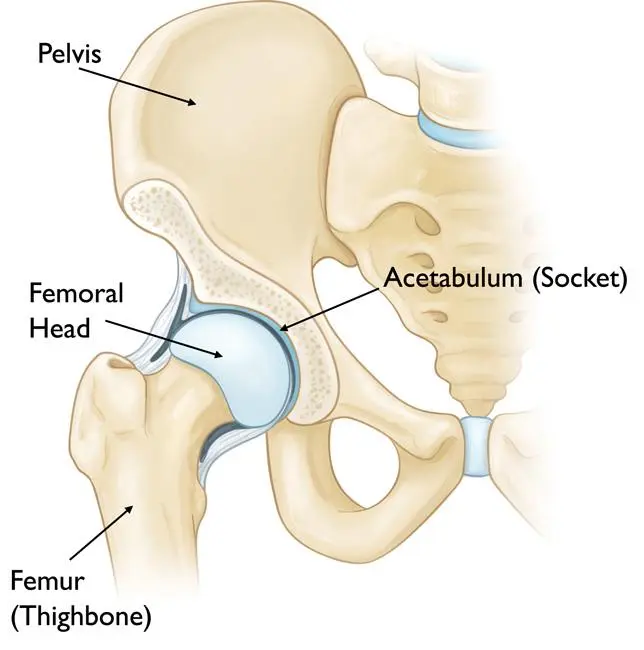
The bone surfaces of the ball and socket are covered with articular cartilage, a smooth, slippery substance that protects and cushions the bones and enables them to move easily.
The surface of the joint is covered by a thin lining called the synovium. In a healthy hip, the synovium produces a small amount of fluid that lubricates the cartilage and aids in movement.
Description
Osteoarthritis is a degenerative type of arthritis that occurs most often in people 50 years of age and older, though it may occur in younger people, too.
In osteoarthritis, the cartilage in the hip joint gradually wears away over time. As the cartilage wears away, it becomes frayed and rough, and the protective joint space between the bones decreases. This can result in bone rubbing on bone. To make up for the lost cartilage, the damaged bones may start to grow outward and form bone spurs (osteophytes).
Cause of Osteoarthritis of the Hip
Osteoarthritis has no single specific cause, but there are certain factors that may make you more likely to develop the disease, including:
- Increasing age
- Family history of osteoarthritis
- Previous injury to the hip joint
- Obesity
- Improper formation of the hip joint at birth, a condition known as developmental dysplasia of the hip
Even if you do not have any of the risk factors listed above, you can still develop osteoarthritis.
Symptoms
The most common symptom of hip osteoarthritis is pain around the hip joint. Usually, the pain develops slowly and worsens over time, although sudden onset is also possible. Pain and stiffness may be worse in the morning, or after sitting or resting for a while. Over time, painful symptoms may occur more frequently, including during rest or at night. Additional symptoms may include:
- Pain in your groin or thigh that radiates to your buttocks or your knee
- Pain that flares up with vigorous activity
- Stiffness in the hip joint that makes it difficult to walk or bend
- “Locking” or “sticking” of the joint, and a grinding noise (crepitus) during movement caused by loose fragments of cartilage and other tissue interfering with the smooth motion of the hip
- Decreased range of motion in the hip that affects the ability to walk and may cause a limp
- Increased joint pain with rainy weather
Risk factors
- Previous hip trauma (causing injury or fracture) – mostly resulting in unilateral hip osteoarthritis
- Primary inflammatory arthritis (e.g. rheumatoid arthritis, ankylosing spondylitis)
- Joint morphology
- Genetics
- Congenital and developmental hip disease (e.g. congenital hip dislocation, Perthe’s disease, slipped upper femoral epiphysis, developmental hip dysplasia)
- Subchondral bone defects
- Obesity – mostly resulting in bilateral hip osteoarthritis
- Occupation causing excessive strain on hips (e.g. manual labor causing repeated loading)
- Increase in age
- Gender (female > male)
- Sport (higher impact sports at a younger age can cause an increase in articular cartilage strength, whereas low impact sports do not change the composition of the cartilage)
- Menopause
- Metabolic diseases and acromegaly
- Sedentary lifestyle
- Femoroacetabular impingement
- Avascular necrosis
- Ethnicity – 80-90% less prevalent in the Asian population when compared to the Caucasian population in the USA
- Diet – low Vitamin D, C, and K levels
Diagnosis
Doctor Examination
During your appointment, your doctor will talk with you about your symptoms and medical history, conduct a physical examination, and possibly order diagnostic tests, such as X-rays.
Physical Examination:
During the physical examination, your doctor will look for:
- Tenderness about the hip
- Range of passive (assisted) and active (self-directed) motion
- Crepitus (a grating sensation inside the joint) with movement
- Pain when pressure is placed on the hip
- Problems with your gait (the way you walk)
- Any signs of injury to the muscles, tendons, and ligaments surrounding the hip
Imaging Tests
X-rays. These imaging tests create detailed pictures of dense structures, like bones. X-rays of an arthritic hip may show a narrowing of the joint space, changes in the bone, and the formation of bone spurs (osteophytes).
X-rays of a normal hip and an arthritic hip
(Left) In this x-ray of a normal hip, the space between the ball and socket indicates healthy cartilage. (Right) This x-ray of an arthritic hip shows severe loss of joint space and bone spurs.
Other imaging tests. Occasionally, a magnetic resonance imaging (MRI) scan, a computed tomography (CT) scan, or a bone scan may be needed to better determine the condition of the bone and soft tissues of your hip.
Treatment:
Although there is no cure for osteoarthritis, there are a number of treatment options that will help relieve pain and improve mobility.
Nonsurgical Treatment
As with other arthritic conditions, early treatment of osteoarthritis of the hip is nonsurgical. Lifestyle modifications. Some changes in your daily life can protect your hip joint and slow the progress of osteoarthritis.
- Minimizing activities that aggravate the condition, such as climbing stairs.
- Switching from high-impact activities (like jogging or tennis) to lower-impact activities (like swimming or cycling) will put less stress on your hip.
- Losing weight can reduce stress on the hip joint, resulting in less pain and increased function.
Medications:
If your pain affects your daily routine, or is not relieved by other nonsurgical methods, your doctor may add medication to your treatment plan.
- Acetaminophen is an over-the-counter pain reliever that can be effective in reducing mild arthritis pain. Like all medications, however, over-the-counter pain relievers can cause side effects and interact with other medications you are taking. Be sure to discuss potential side effects with your doctor.
- Nonsteroidal anti-inflammatory drugs (NSAIDs) may relieve pain and reduce inflammation. Over-the-counter NSAIDs include naproxen and ibuprofen. Other NSAIDs are available by prescription.
- Corticosteroids (also known as cortisone) are powerful anti-inflammatory agents that can be taken by mouth or injected into a painful joint.
Surgical Treatment
Your doctor may recommend surgery if your pain from arthritis causes disability and is not relieved with nonsurgical treatment.
Osteotomy: Either the head of the thighbone or the socket is cut and realigned to take pressure off of the hip joint. This procedure is used only rarely to treat osteoarthritis of the hip.
What Is Hip Resurfacing?
Hip resurfacing is a surgical option that can provide relief while delaying hip replacement surgery. In hip resurfacing, the diseased hip joint surfaces are removed surgically and substituted with metal. However, the entire femur bone is preserved. That makes future hip replacement surgeries possible. Rather than removing the ball of the hip socket, the surgeon covers it with a metal cap.
What Is Hip Replacement Surgery?
The hip joint is a ball-and-socket mechanism. The ball is located at the top of the thigh bone (femur). Your doctor will remove both the damaged acetabulum and femoral head. Total hip replacement surgery replaces the damaged ball with a metal ball. The hip socket is resurfaced using a metal shell and a plastic liner.
Complications
Although complications are possible with any surgery, your doctor will take steps to minimize the risks. The most common complications of surgery include:
- Infection
- Excessive bleeding
- Blood clots
- Hip dislocation
- Limb length inequality
- Damage to blood vessels or arteries
Physical therapy
Specific exercises can help increase your range of motion and flexibility, as well as strengthen the muscles in your hip and leg. Your doctor or physical therapist can help develop an individualized exercise program that meets your needs and lifestyle.
Assistive devices:
Using walking supports like a cane, crutches, or a walker can improve mobility and independence. Using assistive aids like a long-handled reacher to pick up low-lying things will help you avoid movements that may cause pain.
Prevention of Hip Osteoarthritis:
One method for preventing osteoarthritis of the hip is to maintain a healthy weight.
In addition, you should exercise. Exercise strengthens muscles around joints. Such strengthening can help prevent wear and tear on cartilage in a joint. Your healthcare provider may be able to offer additional suggestions to minimize your risk for hip osteoarthritis.
Exercises for osteoarthritis of the hip
Exercise is essential for reducing the risk of osteoarthritis and slowing its progress. Exercise not only helps you manage your weight, but it also improves strength, flexibility, and mobility.
Low-impact exercises are less likely to put a strain on a damaged joint. Experts strongly recommend tai chi for people with hip osteoarthritis.
Other options include:
- yoga
- cycling or using a stationary bike
- swimming or water exercise
- strengthening exercises
- walking
- If you haven’t exercised for a while, ask your healthcare provider or physical therapist for suggestions. They can help you create a program that will suit you and minimize the chance of injury.
- Motivation is important when exercising for health.
Stretching and flexibility
Regular stretching can help relieve stiff, achy, or painful joints. Here are some tips to help you stretch safely:
- Start by asking a physical therapist for suggestions and guidance.
- Do all stretches gently and build up flexibility slowly.
- Stop if you feel pain.
- Increase intensity slowly.
- If you don’t feel pain after the first few days of an activity, gradually spend more time on it. At first, you may find it hard to stretch very far, but your flexibility will increase over time, as you practice.
Here are a few possible stretches:
Forward fold

Start with your feet shoulder-width apart or sit in a chair. Slowly lean forward, keeping your upper body relaxed. You should feel the stretch in your hips and lower back.
Knee pull
Lie on your back. Pull your bent knee up toward your chest until you feel a stretch. If your body allows it, use your other leg to deepen the stretch.
Extended leg balance
This is the same exercise as the knee pull, but you start from a standing position. Place one hand along the wall for support.
Cobra Stretch
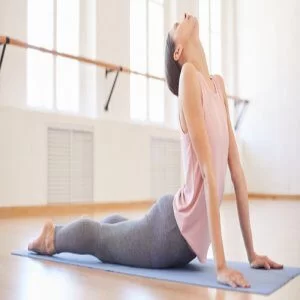
Start by lying facedown on the floor. Your palms should be on the floor at shoulder or chest height. Push against your palms to lift your chest off the floor. Feel the stretch in your lower back and hips. Hold this position for 10 seconds. Release. Repeat two or three times.
Here are some other stretches you can ask your healthcare provider about:
- standing hip flexors
- sitting stretch
- side angle pose
- seated spinal twist
Ask your healthcare provider before starting any stretches or exercises for your hip.
Exercises to Help Relieve Hip Arthritis Pain
Hip Exercise: Clock Tap
Improves balance and stability, and strengthens muscles in your hips and legs
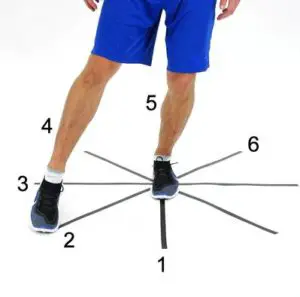
- Stand next to a wall or door frame for support.
- Balance on the right foot; hold on to the wall or door frame to stay steady, if needed. Keep your knee straight over your ankle, with a slight bend.
- Tap your left foot around your right foot, as if your right foot is the centerpiece on a clock, and your left is touching numbers on a clock face. Start at 12 o’clock, then tap at 11, 10, and 9.
- Retrace the numbers back to 12; then tap 1 and 2, and retrace back to 12.
- Repeat the sequence four times; then complete with the opposite foot.
- Tip: Stay within a comfortable and stable range of motion when tapping “around the clock,”. If your knee starts to shift over as you tap for the 9 spot, you may be past your range. As you get stronger, you may be able to reach further on each side.
Hip Exercise: Standing Iliotibial Band Stretch
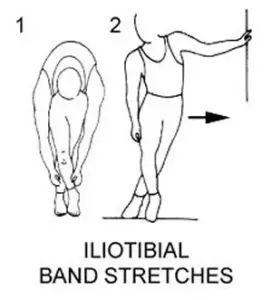
- Stretches the outside of your hip.
- Stand next to a wall for support.
- Cross the leg that is closest to the wall behind your other leg.
- Lean your hip toward the wall until you feel a stretch at the outside of your hip. Hold the stretch for 30 seconds.
- Cross the leg that is further from the wall behind your other leg.
- Repeat on the opposite side; then repeat the entire sequence four times.
- Tip: Don’t lean forward or twist at the waist.
Hip Exercise: Knee to Chest

- Stretches your buttocks
- Lie on your back on the floor with your legs extended straight out.
- Bend one knee and grasp your shinbone with your hands.
- Gently pull your knee toward your chest as far as you’re comfortable.
- Hold the stretch for 30 seconds and then relax for 30 seconds.
- Repeat on the other side, then pull both legs in together. Repeat the entire sequence four times.
- Tip: Keep your lower back pressed into the floor.
Hip Exercise: Hamstring Stretch
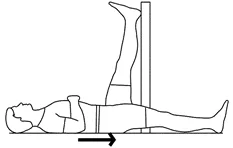
- Stretches the back of your thigh and behind your knee
- Lie on the floor with both knees bent.
- Lift one leg off of the floor and bring the knee toward your chest. Clasp your hands behind your thigh below your knee.
- Straighten your leg and then pull it gently toward your head until you feel a stretch. (If you can’t clasp your hands behind your leg, loop a towel around your thigh. Grasp the ends of the towel and pull your leg toward you.)
- Hold for 30 seconds and then relax for 30 seconds.
- Repeat on the other side; then repeat the entire sequence four times.
- Tip: Don’t pull at your knee joint.
Hip Exercise: Hip Extension
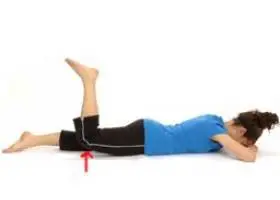
- Strengthens your buttocks
- Lie on your stomach on a firm, flat surface with a pillow under your hips. Keep your head, neck, and upper body relaxed.
- Bend one knee 90°.
- Lift your leg straight up.
- Slowly lower your leg down to the floor, counting to 5.
- Do 8 reps; then complete the exercise on the other side.
- Tip: Begin with 8 reps, using only your body weight; and progress to 12, recommends Dr. Johnson. When that becomes easier, add ankle weights in one-pound increments. Each time you increase the weight, start again at 8 reps, working back up to 12.
Hip Exercise: Sit-and-Stand
- Increases mobility and strengthens leg, core, and back muscles
- Stand in front of a sturdy chair that won’t move, feet planted on the floor about hip-distance apart.
- Press your hips back and bend your knees a little to lower yourself into a seated position.
- Then tip forward from the hips, push through your feet, and up with your legs to a standing position.
- Repeat the sequence 3 times.
- Tip: Gradually build up to 5 or 10 reps, “Sitting and standing are essential movement patterns you want to stay strong in.”
Hip Exercise: Bodyweight Squat
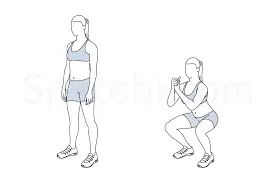
- Progression from the sit-and-stand to help strengthen thighs and buttocks
- Stand with your feet shoulder-distance apart, or a little wider. If needed, hold on to something stable, like the back of a sturdy chair or kitchen sink.
- Keep your chest lifted and shift your weight back into your heels while slowly pushing your hips back, as if you were sitting down in a chair.
- Keep your feet flat and lower yourself as far as you’re comfortable (such as a quarter or halfway down to where a chair would be).
- Push through your heels and bring your body back up to standing.
- Repeat the sequence 3 times; gradually build up to more reps.
- Tip: Keeping your feet a little wider than shoulder distance apart is better for balance when you are struggling with hip pain
Hip Range-of-Motion Exercises
Leg Raises

Hold on to the back of a countertop or chair for support with your right hand. Then raise your left leg slowly in front of you, aiming to get it parallel to the ground. Note: This move is challenging even for people without arthritis or hip issues; just keep your leg in a straight line and try to get it as high as you can. Do as many as you can (up to 10) and then switch to the other leg.
Standing Jacks
Standing with your right arm holding onto a chair or countertop for support, raise your left leg out to the side, as though you’re doing the bottom half of a jumping jack. Do as many as you can (up to 10) and then switch to the other leg.
Cross-Body Leg Raises
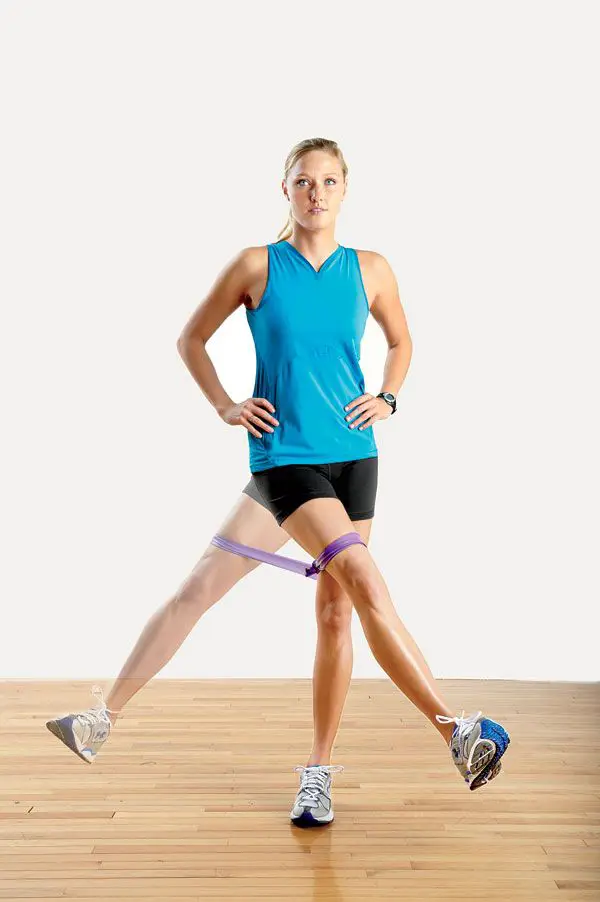
To work your hip joint in the opposite direction, stand with your right arm holding onto a chair or countertop for support. Raise your left leg forward and to the right, so it crosses your midline. Do this slowly and try to raise your leg steadily; you’ll feel a slight tension in your hip, which is normal. Do as many as you can (up to 10) and then switch to the other leg.
Other pain relief
If the methods of pain relief above don’t help you, you might want to try some of the following:
Manual Therapy: Consists of several techniques and stretches performed by physiotherapists. Manual therapy can be an effective treatment to increase the quality and range of movement of the hip.
Transcutaneous electrical nerve stimulation (TENS): a small machine that sends tiny electric shocks, through pads placed on your skin, to relieve pain. TENS machines aren’t suitable for everyone, so talk to your doctor before using one.
Heat therapy: Ice packs and heat packs, such as a hot water bottle or a bag of frozen peas, can relieve some of the pain and stiffness in your hip. But be careful not to put ice or heat packs directly on your skin as they could cause burns. Make sure to wrap them in a damp tea towel or cloth.
Hyaluronic acid injections: hyaluronic acid occurs naturally in the body and helps to lubricate joints. These injections aren’t available on the NHS as they’ve not been proven to be an effective treatment for osteoarthritis.
Supplements: There’s a wide range available, including fish oils, turmeric, glucosamine, and chondroitin. There’s very little evidence on how well they work, but some people do feel benefits from them.
Acupuncture: is a technique where very fine needles are inserted at specific points in your skin. While there is no evidence that acupuncture is an effective treatment for hip osteoarthritis, some people find that it helps them.
Heat Therapy for Arthritis: 8 Simple Ways to Do It at Home
You take your meds, as you should. Maybe you see a physical therapist regularly or do yoga now and then to help manage arthritis symptoms — also smart moves. But even if you’re good about sticking to your treatment plan, there will be mornings when it’s tough to get your body moving. And there will be times when stiff, achy joints make tasks tough. And that is when you should try heat therapy.
“Heat therapy is primarily used to decrease pain and improve muscle flexibility in patients with arthritis.”
Heat therapy won’t change or improve your condition, but it can help relieve arthritis symptoms.
How Heat Therapy Works for Arthritis Pain
Think of heat therapy as a way to thaw joints that are frozen stiff: The heat warms both the skin and the joints. That causes blood vessels to dilate, which gets more oxygen and nutrients to the joints and muscles.
“Improved blood flow to the tissue in the area helps remove pain-producing metabolites,” Plus, heat stimulates receptors in your skin, decreasing pain signals sent to the brain.
Another way heat therapy helps arthritis is that it loosens muscles to decrease spasms and reduce joint stiffness. “Heat therapy also improves flexibility by allowing the collagen — cells that make up connective tissue — to deform easily, leading to improvement in range of motion.”
Heat therapy affects the body the same way, no matter what kind of arthritis you have. When you need it, however, may differ: People with RA or other kinds of inflammatory arthritis tend to experience morning stiffness that lasts a few hours. Starting your day with a warm shower, for example, will help ease symptoms so you can move better. If you have osteoarthritis (OA), symptoms may set in after prolonged sitting, so you may use heat at different times throughout the day.
Do Heat Therapy at Home
Moist heat penetrates deeper than dry heat from a heating pad, so you get more relief. Limit heat therapy to no more than 20 minutes per session, and make sure the heat feels warm, but not burning. Talk to your doctor before trying any new therapy.
- Take a warm shower
And while you’re in there, do gentle range-of-motion exercises, like neck rotations and wrist extensions. - Or soak in a warm tub
Immerse your body for 15 to 20 minutes to allow weight-bearing muscles to relax. Afterward, dress warmly to prolong the benefit. - Make a DIY hot pack
Heat a damp, folded towel in the microwave for 20 to 60 seconds (depending on the towel’s thickness). To prevent burns, always test the heated towel on the inside of your arm before putting it on your joint: It should feel comfortably warm, not hot. For an added layer of protection, wrap the heated, moist towel in a thin, dry one before placing it on the skin. You can also fill a rubber or soft plastic water bottle with hot water and rest it on an achy joint. - Or buy a moist heating pad, pack, or wrap
Some are specifically designed to fit your knees, neck, hand, or other joints. - Try a paraffin bath
This warm wax treatment is typically used for hands and sometimes feet. Dip your hand (or foot) several times to coat it with wax, wrap it in plastic or with a towel to retain heat for about 20 minutes, then peel off the wax. Be sure to follow the manufacturer’s instructions and monitor for any skin reactions. - Or mineral oil and gloves
Massage some oil onto your hands, put on rubber dishwashing gloves, and run your hands under hot tap water for 5 to 10 minutes. - Stretch after heat therapy
While your joints and muscles are warm, do gentle stretches or simple range-of-motion exercises to increase mobility. - Ask about deep heat therapies
A physical therapist can perform other forms of heat therapy, such as diathermy and ultrasound, that reach below the skin surface to the connective tissue and muscle. Talk to your doctor to see if this therapy is right for you.
When to Try Ice Therapy for Arthritis Instead
If you have inflammation with OA, a cold is better. Cold can numb pain by causing blood vessels to constrict, which helps reduce swelling.
Self-care routines
Experts say that self-management is essential for treating osteoarthritis.
This includes:
- learning as much as you can about your condition
- knowing what your treatment options are
- Take an active part in managing your pain and other symptoms
- discussing what is best for you with your healthcare provider
- taking care of yourself regarding both diet and nutrition, restorative sleep, and appropriate exercise
- Lifestyle factors that can contribute to hip arthritis include:
- dietary choices
- type and level of physical activity
- use of tobacco and alcohol
- getting appropriate care for other mental and physical health conditions
- establishing healthy sleeping habits
- Osteoarthritis can also affect a person’s mental health. Staying active and making positive lifestyle choices can help reduce the risk of depression and anxiety with osteoarthritis.
Here are some self-care tips that may offer relief:
- Get enough rest. Establish regular sleeping habits and rest when symptoms feel worse than usual.
- Manage stress. Exercise, meditation, and listening to music may help you relax, avoid stress, and lift your mood.
- Follow a healthy diet. A diet that’s rich in fresh fruits and vegetables and low in added sugar and fat can help you feel better and maintain a healthy weight. Opt for fresh, whole foods rather than processed ones.
- Stay in touch. Meeting with friends, perhaps for exercise, can help relieve stress and keep you healthy.
- Avoid tobacco and limit alcohol. These add to overall health problems and may worsen inflammation.
- Supplements and alternative therapies
- Some people have also tried using natural therapies to treat hip arthritis.
There’s some evidence that the following may help:
- acupuncture
- cognitive behavioral therapy (CBT)
- application of heat pads
- using topical ointments that warm the area, such as capsaicin
Aerobic exercise
Aerobic exercise, also called cardio or endurance exercise, is an activity that makes your heart beat faster. It’s good for your heart and can help keep you physically fit overall, but be careful not to overly stress your hip joints.
Check with your doctor before beginning a new aerobic exercise routine. Depending on what you can physically handle, examples of low-impact aerobic exercises include:
- speed walking
- vigorous swimming
- stationary bike
- aerobic dance
FAQ
Is walking good for hip osteoarthritis?
Walking helps enhance hip flexibility and range of motion by releasing tension in the hip flexors. lessen hip inflammatory response. Walking as exercise increases blood flow to your hip joint cartilage, which helps reduce inflammation. Arthritis is a condition that causes persistent inflammation.
What is the best exercise for osteoarthritis in the hip?
The best exercises for osteoarthritis in the hip are:
Walking.
Stationary bike
Water exercises
Yoga
Tai chi
Is sitting bad for hip osteoarthritis?
Standing up and stretching or rotating the hips in an arc of motion might help reduce the “start-up” discomfort that many people who work at desks have when they first wake up from extended periods of sitting still.
Can you recover from hip osteoarthritis?
The kind and stage of the condition, your age, the level of discomfort, and other variables all affect your treatment options for hip arthritis. Although cartilage loss cannot be stopped, there are strategies to lessen discomfort and stop further damage.


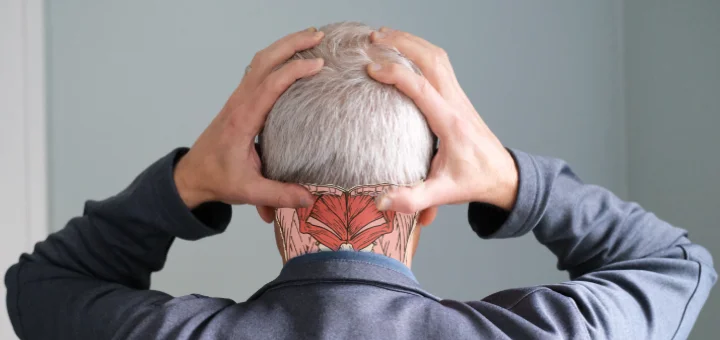
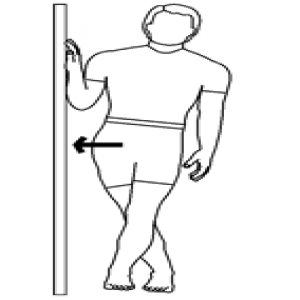
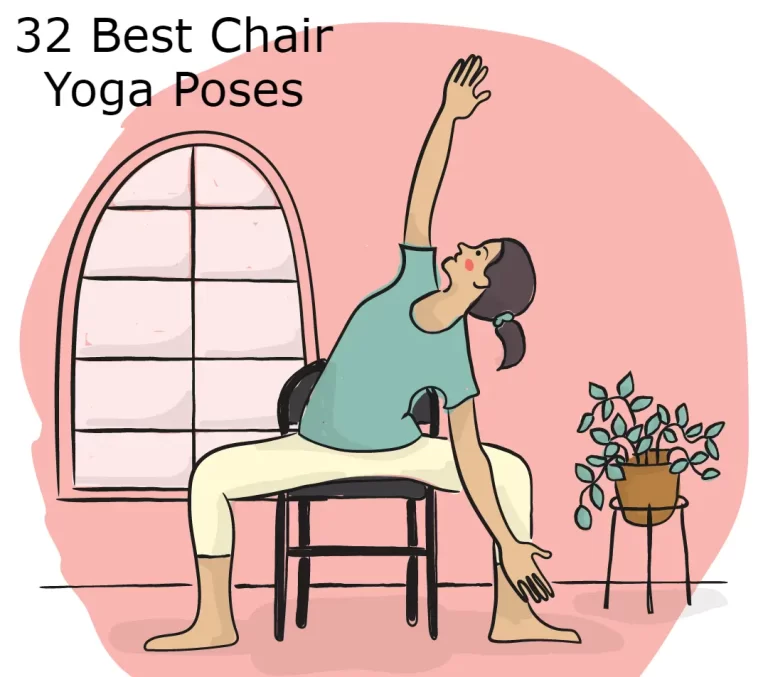
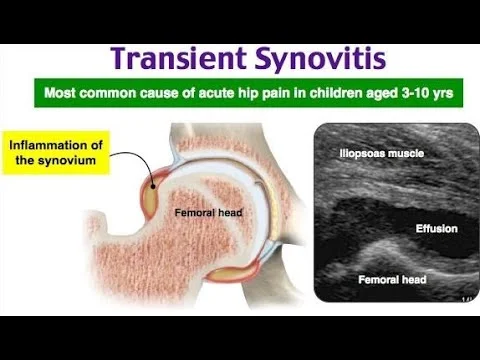
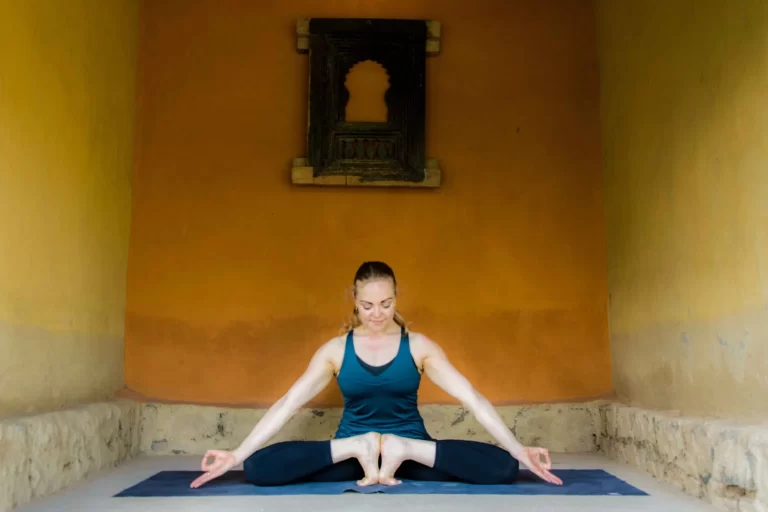
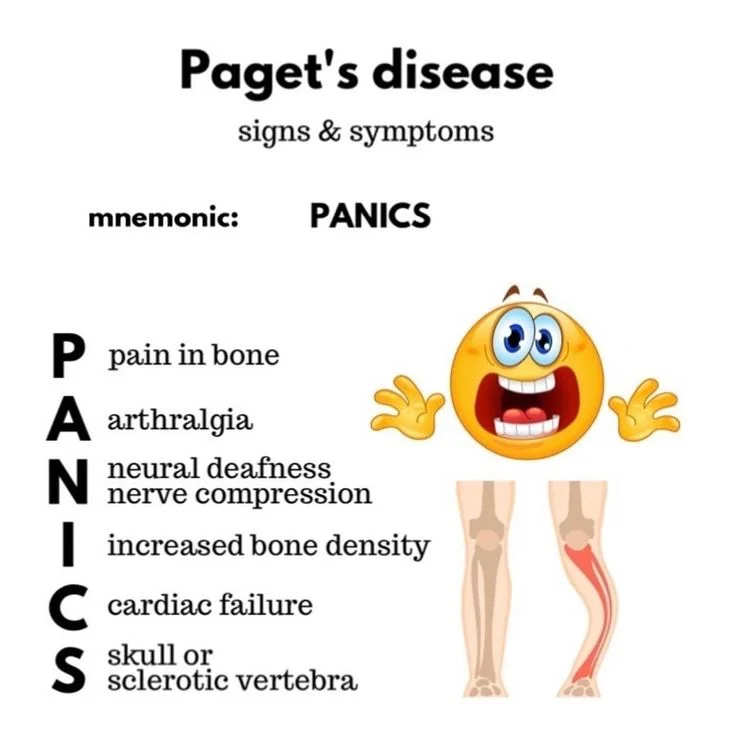
14 Comments